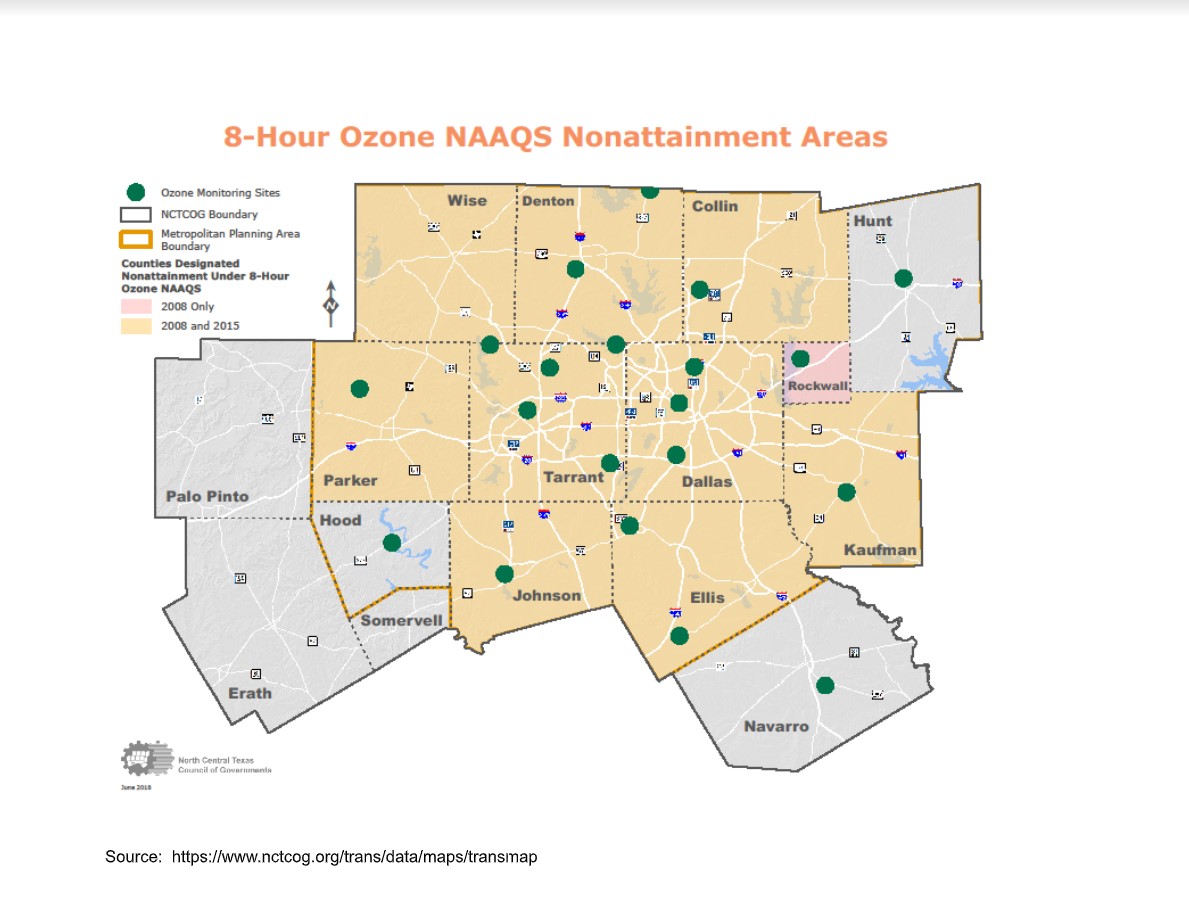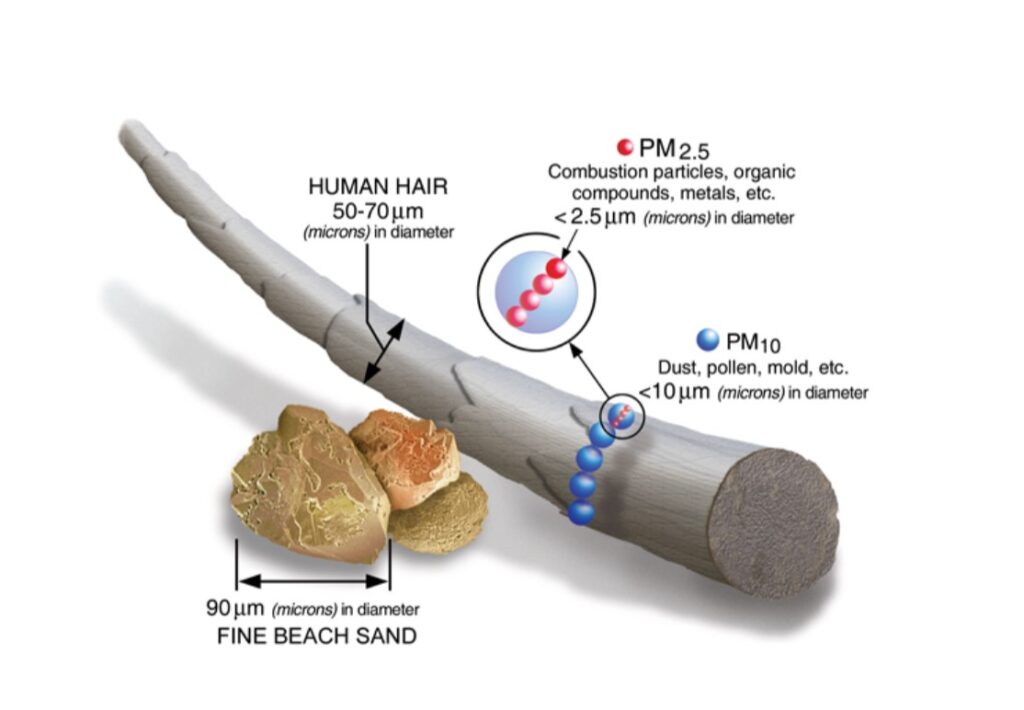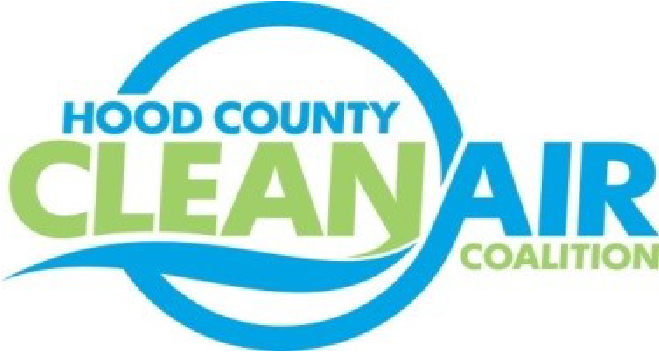Clean Air Education
Want to know more about Air Quality, Air Pollutants, or how you can help improve your air?
The Clean Air Act requires the Environmental Protection Agency (EPA) to set National Ambient Air Quality Standards (NAAQS) for pollutants that are considered harmful to public health or the environment. These are classified into two groups: primary standards which protect public health including sensitive populations of asthmatics, children, and the elderly and secondary standards that protect public welfare aspects including reduced visibility and damage to animals, crops, vegetation, and buildings. The NAAQS addresses six principal pollutants.
| Pollutant | Standard Groups |
|---|---|
| Carbon Monoxide (CO) | Primary |
| Lead (Pb) | Primary and Secondary |
| Nitrogen Oxides (NOx) | Primary and Secondary |
| Ozone (O3) | Primary and Secondary |
| Particulate Matter (PM) | Primary and Secondary |
| Sulfur Dioxide (SO2) | Primary and Secondary |
The pollutants of concern for Hood County and the Dallas/ Fort Worth area are ozone and particulate matter. In 2015, the latest standard was strengthened to 70 ppb for the eight-hour average. EPA makes determinations if areas are meeting the standard, in which case they are designated in “attainment” or not meeting the standard, in which case they are designated “non-attainment”.
These determinations are based on information from air quality monitoring data, recommendations by states and tribes, and other technical information. If an area is designated “non-attainment”, the state and local government is required to take several steps that include stricter controls on industrial facilities, additional planning requirements for transportation related sources, potential implementations of “transportation conformity” which requires local transportation and air quality officials to ensure that emissions from transportation projects like road construction do not interfere with an area’s ability to reach clean air goals, and new source review requirements that require a permitting program for industrial facilities. These steps result in economic consequences that may restrict development in the area designated, “non-attainment”.
For particulate matter, a primary and secondary standard for was first established in 1971 for 24 hours and for annual. In 2024, the primary annual PM2.5 standard was strengthened to 9 micrograms per meter cubed and the other PM2.5 and PM10 standards were retained. Designations related to the new primary annual PM2.5 standard are not completed yet, but the Dallas/ Fort Worth has some areas that are at risk of a non-attainment designations for the new PM2.5 standard.
(source: epa.gov/pm-pollution)
Below is a map of the DFW 8-Hour Ozone NAAQS Nonattainment Area with the region’s air quality monitors noted.

What is Ozone?

Ozone is a gas formed when three atoms of oxygen combine. Ozone occurs in the upper atmosphere and near ground level.
Depending on where it occurs, ozone can be “good” or “bad”.
Good Ozone is found in the upper atmosphere where it is formed when the more common two-atom form of oxygen (O2) reacts with ultraviolet (UV) radiation from the sun to from the three-atom oxygen, ozone (O3). This upper atmosphere ozone is beneficial as it forms a protective layer to shield the Earth from dangerous UV rays from the sun.
Bad ozone is found near ground level and is considered a “secondary” pollutant- meaning it is not directly emitted but is formed by a chemical reaction of “formative” emissions. Nitrogen oxides (NOx) and volatile organic compounds (VOC) are the “formative” emissions of ozone. These emissions react in the presence of heat and sunlight to form the detrimental ground level ozone. Ground level ozone is a component of smog and is regulated by the EPA. (source: epa.gov/groundlevelozone)
Sources of NOx and VOC
- NOx are byproducts of combustion, particularly of fossil fuels.
- Common Sources are:
- Automobiles and Trucks
- Construction Equipment
- Electric utility generation
- Industrial Facilities
- Gas powered lawn equipment
- VOCs are organic chemicals, containing carbon and hydrogen, which vaporize easily.
- Common sources are gasoline vapors and solvents including emissions from:
- Gas stations
- Petroleum storage tanks
- Oil refineries
- Biogenic (natural emissions from trees and plants including oaks, pines, sweet gum, and poplars)
Reduction of NOx and VOC emissions restricts the formation of ozone.
See What Can I Do at the bottom of this page for ways that individuals can help reduce these emissions.
What is Particulate Matter (PM)?
Particulate matter is the term used to refer to solid particles and liquid droplets in the air.
Some particles are large enough to see like dust, dirt, soot, or smoke while others can only be detected with a microscope. PM10 are inhalable particles with diameters 10 micrometers and smaller like dust, pollen, and mold and PM2.5 are fine inhalable particles like combustion particles, organic compounds and metals with diameters that are about 2.5 micrometers or smaller. For comparison’s sake, a human hair is 50-70 micrometers, and a grain of beach sand is 90 micrometers. (source: epa.gov/pm-pollution)

Sources of PM
Some particulate matter particles are emitted from construction sites, unpaved roads, fields, smokestacks, and fires. Other particles are in the atmosphere because of chemical reactions such as sulfur dioxide and nitrogen oxides which are emitted from power plants, industrial production, and vehicles. (source: epa.gov/pm-pollution)
Air Quality Index

(source: airnow.gov)
The Air Quality Index indicates when ozone or particulate matter levels are unhealthy and is usually reported with the weather forecast, in newspapers, and on websites including the homepage of this website.
Health Impacts of Ground-level Ozone
Certain groups are at greater health risk from ozone exposure. These groups include children, older adults, active people, and people with lung disorders. Children are at greater risk because they play outdoors in the summer when ozone levels are likely to be higher, their lungs are still developing, and they are more likely to have asthma. Older adults are at greater risk because they are more likely to have pre-existing lung disease. Active people, especially those that work outside, are at greater risk due to greater exposure to ozone. People with lung disorders including asthma, chronic bronchitis, and emphysema are at greater risk from ozone exposure because they experience more serious health effects at lower ozone levels.
Negative effects of ozone include:
- Irritation of the respiratory system
- Reduced lung function
- Inflammation and damage to cells that line the lungs
- Increased lung susceptibility to infection
- Aggravated asthma, emphysema, and chronic bronchitis
- Cause lung damage
(source: https://www.epa.gov/ground-level-ozone-pollution/ground-level-ozone-basics)
Health Impacts of Particulate Matter
Certain groups are at greater health risk from ozone exposure. These groups include children, older adults, active people, and people with lung disorders. Exposure to small particles less than 10 micrometers per meter cubed are small enough to get deep into the lungs and some may get into the bloodstream. Exposure to these particles can affect both the heart and the lungs and they have been linked to health issues like:
- Premature death for people with heart or lung disease
- Nonfatal heart attacks
- Irregular heart beats
- Respiratory issues including aggravated asthma, decreased lung function, and irritation of the airways.
Environmental impacts from PM2.5 are related to to reduced visibility due to haze. These small particles can be carried long distances and can, depending on their composition:
- May make lakes and streams acidic
- Deplete soil nutrients
- Damage forests and crops
- Contribute to acid rain effects
(Source: epa.gov/pm-pollution)

What can I do to reduce O3 and PM?
- Minimize vehicle trips by working remotely or attending meetings virtually when possible
- Carpool or vanpool to work
- Combining errands
- Bike or walk instead of driving when possible
- Observe the speed limit
- Eat lunch at your office
- Avoid idling your vehicles
- Wait to refuel vehicles after sunset
- Maintain vehicle tire pressure
- Choose a clean vehicle option like a SmartWay or an electric or hybrid option if purchasing a new vehicle (https://www.epa.gov/smartway)
- Pursue energy efficient home improvements
- Switch to LED lighting
- Sign up for ozone alert notifications through TCEQ or Air North Texas (https://www.airnorthtexas.org/)
- Join the Air North Texas campaign for free and commit to doing something for clean air
Alternative Fueling Stations from the Alternative Fuels Data Center
